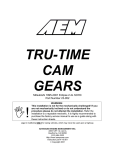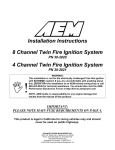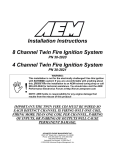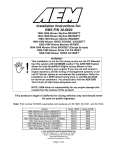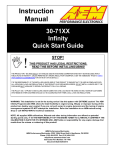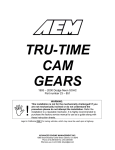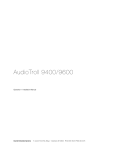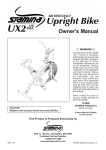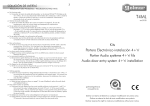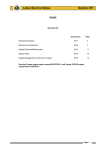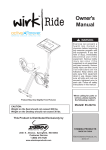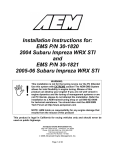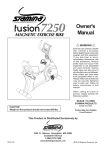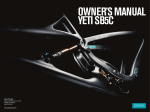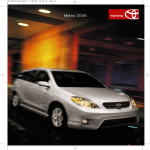Download INSTRUCTION MANUAL PLUG AND PLAY EMS KIT LOTUS ELISE
Transcript
INSTRUCTION MANUAL PLUG AND PLAY EMS KIT LOTUS ELISE/EXIGE/2-ELEVEN 2004+ with 2ZZ-GE ENGINE DOCUMENT 19-0046 Radium Engineering LLC ©2012, All right reserved Table of Contents 1. 2. 3. 4. 5. 6. 7. 8. 9. Introduction Warnings and Cautions Before Getting Started 2004-2005 EMS Mounting 2006+ EMS Mounting Installation of Accessories Before Initial Start-Up Engine Tuning Tables and Pinouts 1. INTRODUCTION The Radium Engineering Plug and Play Engine Management System (EMS) gives the user complete control over all engine parameters and also adds extra functionality for modified vehicles. The Radium EMS itself is a highly modified AEM EMS-4. The stock ECU is retained to run the CAN-BUS dashboard, electronic throttle (when equipped) and other secondary tasks. The EMS gives the user full control over fueling, ignition timing and VVTi-L (cam position and lift). It also offers added features such as electronic boost control, wideband O2 feedback, traction control, data logging, and much more. To get familiar with the AEM EMS-4, reference the CD included in the kit. Download the AEMTuner software and user manual. Note: visit www.aempower.com to get all of their latest updates. Read all accompanying literature and become familiar with the operation of an AEM EMS-4 and how it functions. Install the AEMTuner software on a laptop that can be used for initial start-up checks. The EMS is shipped from Radium without a start-up calibration loaded. The engine will NOT start without a loaded calibration file. Calibrations can be downloaded from www.radiumauto.com. The calibration supplied by Radium is not a final tune. The vehicle must still be evaluated by a professional tuner familiar with AEM software and tuning. 2. WARNINGS AND CAUTIONS Use this system with EXTREME caution! The EMS System allows for total flexibility in engine tuning, however misuse of this product can lead to major engine/vehicle damage. If you are not well versed in engine dynamics and the tuning of management systems or are not PC literate, please do not attempt installation or tuning of this product. For technical assistance, please visit the AEM Electronics Forum or visit a local qualified AEM tuner near you. Radium and AEM hold no responsibility for any engine damage that results from the misuse of this product! Failure to follow proper precautions may result in engine damage or other collateral damage. Radium will not be held responsible for any damage resulting from poor tuning or improper installation. -Before driving the car, the calibration must be checked by a professional. Pre-loaded calibrations are only a starting point for tuning and should not be considered fully safe. -All inputs and outputs should be verified before starting the vehicle. This is done by connecting a laptop computer and communicating with the EMS. Engine parameters can be observed and verified. -All preliminary tuning should be done with high-octane fuel as an added safety factor to resist accidental detonation from tuning. -This EMS system is NOT EMISSIONS COMPLIANT and as a result is legal for off-highway use only. 3. BEFORE GETTING STARTED For installations that are using a Radium Turbocharger kit, the rear clamshell should ideally be removed to gain easy access for installation (running wires, vacuum lines, etc). Radium sells clamshell kits that help make this process easier. For installations in naturally aspirated or factory supercharged vehicles, clam shell removal is not necessary but will help speed the installation. Alternatively, for naturally aspirated vehicles, simply removing the deck lid (or hatch) will allow access to the critical areas for the plug and play installation. Familiarize yourself with the location of engine control related components. If installing gauges, a mounting location must be determined. Access to the area behind the LH seat is required for the EMS installation. Removal of the speaker panel is necessary. The following components are included in the basic Radium Lotus EMS kit: JUMPER BOX All Lotus EMS kits use a Radium jumper box (shown on right). The jumper box consists of a conformal coated printed circuit board and a billet aluminum enclosure. The factory Lotus ECU connectors plug into this unit making the kit plug and play. The included main harness plugs into the other side of the jumper box. This unit always mounts in the engine bay. However, depending on the model year of the Lotus, this jumper box may mount as such or 180 degrees rotated. The jumper box’s connector header that matches the engine harness’ connectors will always face downwards. RADIUM/AEM EMS-4 The circuitry of the AEM EMS-4 included in the kit has been modified by Radium Engineering to make it compatible with the Lotus electronics. Do not replace the Radium EMS with a standard off-the-shelf AEM EMS-4 that does not have a Radium sticker. Contact Radium Engineering should a replacement be needed. MAIN WIRING HARNESS The model specific main wiring harness is included and links the jumper box to all other components in the system including the Radium EMS. This harness is custom engineered for the Lotus application by Radium Engineering and makes installation plug and play. Radium Main Harness, 2004-2005 Lotus Radium Main Harness, 2006-up Lotus LOTUS ECU CONNECTORS The ECU connectors used on the 2004-2005 Lotus models are different than the 2006+ ECU connectors. Understanding how both of these connectors work will make installation easier. Experiment with these connectors and the Radium jumper box to see how they work before the system is installed in the car. Familiarity with both connector styles is required for all installations. The 2006+ connectors use a rotating latch to lock the connector to the header. Shown at left is a connector in its fully unlocked state ready to be inserted into the header. After insertion, rotate the latch and it will draw the connector into the header. Once fully engaged, the latch will lock in place. To release, push the small release button with your thumb (shown) and rotate the latch back to the unlocked position. The 2004-05 connectors use "slide locks" to engage the connectors with the headers. The picture shown depicts the slide in the fully unlocked state. The slide has a tab that can be pulled to release the latch mechanism. The slide must be fully open, as shown, in order for the connector to be inserted into the header. Once inserted, push the slide closed to fully engage the connector to the header connector. 4. 2004-2005 EMS SYSTEM MOUNTING Follow the instructions below if installing the Radium Plug and Play EMS kit on a 2004-2005 Lotus with a cable actuated throttle body. 1. Disconnect battery negative cable. 2. Locate the factory engine control unit (ECU) on the firewall, near the engine intake manifold. 3. Unplug both the connectors going into the ECU. This is done by pulling the connector slide lock mechanism, as shown. 4. Situate the Radium main wiring harness in the engine bay and plug the connectors that match the factory connectors (from previous step) into the factory ECU. Make sure the slide locks are in the unlocked position as the connector is inserted into the ECU header. Once inserted and seated, slide the lock closed and the connector will fully engage into the header. Do this for both connectors. 5. Use a 10mm socket to remove the LH side nut holding the ECU to its mounting bracket, leave the washer in place. Using a 13mm socket, remove the other mounting nut on the bottom RH side of the ECU. Leave ECU in place and do not remove from firewall. In the EMS kit, locate the two hex standoffs. Thread these onto the aforementioned studs. They have different thread pitches to correspond with the threaded studs (green = M8x1.25, black = M6x1.0). Tighten with a ½” wrench or socket. 6. Plug the factory ECU connectors into the Radium jumper box’s lower ECU header. Make sure the slide locks are in the unlocked position as the connector is inserted into the header. Once inserted and seated, slide the lock closed and the connector will fully engage into the ECU header. Do this for both connectors. 7. Use the included M6x1x12mm Allen screw with M6 washer and the M8x1.25x16mm hex screw with M8 washer to mount the Radium jumper box to the hex standoffs from step 5. 8. On the Radium main harness, locate the two ECU connectors similar to what is shown in the picture. Plug these into the top two headers of the Radium jumper box. The plugs are keyed to work in the correct headers and are color coded black and brown. Be careful not to use the incorrect header socket. Once the plug is inserted, rotate the latch which will fully seat the connector and lock it in place. 9. Engine side of the main harness installed. 10. Remove the air intake system and drill out the six rivets holding the air box bracket to the bulkhead wall. Four rivets are located on the vertical face (shown) and two are located on the top face hidden by the carpet. Insert the included M5 button head Allen screws into the holes as place holders until the EMS bracket is installed inside at a later step. 11. To remove the rear speaker panel, it is required to remove the passenger seat and slide the driver seat forward. Gently pull and unstick the immobilizer control unit from the bulkhead wall, as shown. Using the included hook and loop tape (Velcro), relocate the immobilizer to another spot out of the way of the EMS bracket and wiring. 12. Unsnap the grommet from the hole. Using a razorblade, make a slit in the factory wiring harness bulkhead wall grommet from the engine bay side. 13. Feed the Radium main wiring harness through the factory bulkhead wall hole and into the cabin. Start with the EMS connector first then carefully feed the other leads through the hole. Once the harness is fed through, snap the grommet back into the hole. Some trimming may be necessary to make room for the added wires. 14. Secure the EMS and relays to the included mounting bracket and hardware. Plug in the EMS and relays using the connectors from the main harness. Note: the relays are all the same. Route the USB cable and the green connector towards the front of the cabin near the center console. If the optional traction control switch and/or pwr select switch was purchased place it underneath the center console. 15. Slide the EMS bracket behind the roll bar and align the four holes to the drilled holes from the earlier step. Screw the four button head Allen screws from step 10 into the four rivet nuts in the bracket and tighten. The EMS system is now installed. If you purchased the Auxiliary harness, continue reading for additional instructions on how to hook up this harness and the related accessories. 5. 2006+ EMS SYSTEM MOUNTING Follow the instructions below if you are installing the Radium Plug and Play EMS kit on a 2006+ Lotus with electronic throttle control. 1. Disconnect battery negative cable 2. Remove the speaker panel behind the seats on the interior of the car. 3. Remove the air intake filter box. 4. Locate the factory ECU on the bulkhead wall in the engine bay, near the intake manifold. Release the latches on the two ECU connectors and unplug them from the ECU. 5. Remove the four nuts holding the ECU to the bulkhead wall and remove the ECU from the vehicle. 6. Locate the ECU connectors removed in step 4 and plug them into the Radium ECU jumper box. Fully lock the latches in the connectors. Place the ECU jumper box onto the mounting studs on the bulkhead wall. 7. Use the factory M6 nuts and secure the jumper box to the bulkhead wall. 8. Using the ECU mounting bracket included in the Radium EMS kit, mount the Radium EMS using the 3 long included screws. Use 4 of the included M5 screws to mount the factory ECU, as shown above. Note the orientation of each component. Mount the relay to the rivet nut circled using one of the included M5 screws (relay not shown). The other spare rivet nut can be used for the aux relay, if the optional aux harness was purchased. 9. Drill out the rivets on the air box mounting bracket. Four rivets are located on the vertical face (shown) and two are located on the top face hidden by the carpet. 10. Place the EMS bracket into the cavity behind the LH roll bar support on the interior of the vehicle. Line up the four holes around the RA logo with the four drilled out rivet holes from step 9. Insert the included M5 screws from the engine bay side and tighten down. 11. Unsnap the grommet from the hole. Using a razorblade, make a slit in the factory wiring harness bulkhead wall grommet from the engine bay side. 12. Locate the Radium main ECU harness and find the end with the 2005 style ECU connectors. Feed this end through the bulkhead wall pass-through first. Start with the largest connector. 13. From the engine bay side, gently tug and ease the harness through the hole. Next, work the second (smaller) 2005-style ECU connector through the hole. 14. Keep feeding the harness through until the lead for the 12-pin auxiliary harness is fully in the engine bay. 15. Make sure the two 2005-style connectors are in the unlock position and plug them into the top side of the jumper box. Make sure connectors are fully engaged and slide-locks are closed. 16. Inside the cabin, plug the large connector into the EMS as shown. 17. Plug the other two stock ECU connectors into the stock ECU. Make sure the latches fully close and lock the connectors in place. Plug the remaining connector into the relay mounted to the bracket (not shown). The EMS system is now installed. If you purchased the auxiliary harness, continue reading for additional instructions on how to hook up this harness and the related accessories. 6. INSTALLATION OF ACCESSORIES The Radium Plug and Play EMS System has an optional auxiliary harness that makes it easy to hook up extra equipment to be controlled by the EMS. The auxiliary harness attaches to the main harness. Wideband Oxygen Sensor with Gauge/Controller If an aftermarket O2 sensor is used, the factory O2 sensor MUST be unplugged for proper operation. In the optional auxiliary harness, locate the two wires coming from terminals 4 and 11 of the 12-pin gray connector. Note: there are small molded pin numbers on this connector. These short flying leads are tucked away in the sleeving. Gently tug these two wires from the protective loom. They will easily slide out. These are the EMS wires for the wideband oxygen sensor input. Pin 4 is the signal (Analog+) and pin 11 is sensor ground (Analog-). Note: Many aftermarket wideband kits will not require the Analog-. Check the wideband manufacturer for more details. If this is the case, leave this wire disconnected. If an AEM wideband O2 sensor gauge/controller was purchased, install it according to their instructions. The newest AEM gauges will have two output wires: Analog+ and Analog-. Route these two wires from the gauge to the 12-pin gray connector where the auxiliary harness is plugged in, as described above. Connect the Analog+ wire to the wire coming from Pin 4. Connect the Analog- wire to the wire coming from pin 11. Radium recommends soldering the wires together and insulating with shrink tubing. MAP (Manifold Absolute Pressure) Sensor If a MAP sensor is used, the factory MAF sensor MUST be unplugged for proper operation. For Exige-S and 2Eleven applications, the Radium EMS kit can use the factory TMAP sensor. If looking to convert to speed density for all other applications, the optional auxiliary harness contains a connector labeled “MAP Sensor”. Any MAP sensor can be calibrated to work via the AEMTuner software. However, the aux harness is wired for an AEM MAP sensor (or equivalent). Radium sells AEM 3Bar MAP sensor p/n: 30-2130-50. The MAP sensor should be mounted securely and receive a pressure signal from the intake manifold plenum. This can be accomplished by drilling and tapping a 1/8NPT hole in the intake plenum, or remotely mounting the sensor and running a vacuum line from a port on the intake manifold to the sensor. IAT (Intake Air Temperature) Sensor If an aftermarket intake air temperature sensor is used, the factory MAF sensor MUST be unplugged for proper operation. The optional auxiliary harness contains a labeled connector to attach a GM Intake Air Temp (IAT) sensor. This sensor is available from Radium Engineering as part of the “Speed Density Conversion” kit. This sensor can be installed in the intake manifold via a drilled and tapped 3/8NPT hole, or in the intercooler piping after the charge cooler. If installing on a naturally aspirated vehicle, the sensor may go in the intake pipe/airbox or in the intake manifold. Radium Boost Control Solenoid If the vehicle is turbocharged, a Radium Engineering boost solenoid can be purchased for boost control. Within the optional Radium auxiliary harness, a 2 pin connector is already prewired and will plug directly into this controller. The illustration to the right (top) depicts how to plumb the boost hoses when utilizing a turbocharger setup that has an internal wastegate. The illustration to the right (bottom) depicts how to plumb the boost hoses when utilizing a turbocharger setup that has an external wastegate. Note these are only examples of how to plumb the boost solenoid to the wastegate. There are other ways not mentioned in this instruction manual. Spare Output In the standard EMS kit, the output GPIO#6 is used to activate the Lotus Air Box Valve which is used to increase induction sound at high engine speeds. If the optional auxiliary harness was purchased, an integrated fuse and relay comes prewired and can be used for just about anything. The integrated white 2-pin connector will plug into a Spal fan, if needed. However, this output also uses GPIO#6, meaning that both this output and the Lotus air box valve (if still used) will be activated using the same conditions defined in the AEMTuner software. For 04-05 kits, mount the relay and fuse to the spare rivet nuts on the EMS bracket. For 06+ kits, use the one spare rivet nut and secure the fuse holder nearby. Screws included. The spare output requires the aux harness power and ground ring terminals to be connected. There is a factory ground lug and 12V power box both located below the throttle body area on the firewall secured with M8 nuts. Radium PnP Switches The optional plug and play switches do NOT require the Radium auxiliary harness. These are simple to install and do not require cutting or splicing. For 2004-2005 EMS kits, the switches’ green connector will secure to the mating green connector that is part of the Radium main harness. For 2006+ EMS kits, the switches’ green connector will secure to the mating green connector that is found in the factory wiring loom located underneath the center console. If the vehicle came standard with Lotus T/C, the factory switch will not work in this system. If the Radium traction control switch and the Radium power selector switch were both purchased, the Radium Yharness (shown at left) is necessary for proper mounting and connecting. To secure the switches in the factory location, the two Torx bolts on either side of the center console will need to be removed. Pull the center console up just enough to unplug the hazard switch and the factory traction control switch (if applicable). To mount the switches, a ½” drilled hole is necessary for securing. If inserting into the factory traction control switch location (if applicable), no modification is necessary. Note: Traction Control uses GPIO#8 and PWR Select uses GPIO#2 as described in the following section. 7. Before Initial Start-Up Be sure that the vehicle is in the hands of an authorized factory trained AEM tuner. Connect to the Radium EMS using a laptop and USB cable in the main EMS harness. For more detailed information vehicle setup, visit the AEM electronics forum at forum.aempower.com/forum/index.php. Upload the proper calibration file and open the Radium workspace file both found at www.radiumauto.com. Verify that all of the parameters are reading properly, ie: throttle, engine load, coolant temperature, intake air temperature, etc. If applicable, check that the power select switch (GPIO#2) and the traction control switch (GPIO#8) are both triggering ON/OFF when depressing the respective switch. Also test that all of the outputs are working, ie: low speed radiator fan, high speed radiator fan, boost solenoid (if applicable), spare aux output, etc. If an aftermarket wideband O2 sensor was installed, make sure that the factory (pre catalytic converter) primary O2 sensor is unplugged. Otherwise, the O2 sensor signal will be altered and not accurate. If a MAP sensor and IAT sensor was wired into the system, make sure to unplug the factory mass air flow sensor. Otherwise, the MAP sensor and IAT signals will be altered and not accurate. If this EMS kit was installed in an Exige-S, 2-Eleven, or any Lotus that uses both a factory TMAP sensor and the mass air flow sensor, one or the other MUST be unplugged. Otherwise, the engine load signal to the EMS will be altered. On the Exige-S, the TMAP sensor is mounted on the intercooler (as shown) and the mass air flow sensor is mounted on the air intake box. Note: the Radium Exige-S startup map uses the TMAP sensor. However, the mass air flow sensor can be used for engine load calculations instead, if need be. 8. Engine Tuning There is a low RPM rev limiter in ALL of the Radium startup calibrations. This limits the engine revs for pre-tune liability. It is found in: Setup Tab | Main Rev Limits | Fuel Cut. This can be raised when the vehicle is put on a dynamometer and ready to be tuned. Note: The stock Lotus ECU limiter is 8500RPM. If the vehicle does not start, check all of the connections. Go to forum.aempower.com/forum/index.php for troubleshooting. Radium-generated base start-up calibration files and workspace file can be downloaded from the product page at: http://tinyurl.com/a68pnra Toward the bottom of product page, click the link (pictured at right) to download the zip files. In the AEMTuner File menu, open the workspace file. When USB connected to EMS, upload the correct calibration for your particular setup in the ECU menu. 10. Tables and Pinouts The table below illustrates the AEM general purpose input/output that is preset in the Radium EMS kit. GPIO Name I/O 1 VVL Solenoid Output 2 Power Selector Switch Input 3 High Speed Fan Relay Output 4 Slow Speed Fan Relay Output 5 VVTi Solenoid Output 6 Air Box Valve (or Aux Relay) Output 7 Boost Control Solenoid Output 8 Traction Control Switch Input Notes Preset to activate the Toyota variable valve lift solenoid. Preset for the optional Radium power select switch. Common uses are race gas switch and/or high boost switch. It can be used for other miscellaneous I/O. Preset to activate the factory Lotus fast speed radiator fan. Preset to activate the factory Lotus slow speed radiator fan. Preset to control the Toyota variable valve timing solenoid on the intake camshaft. Preset to open the Lotus air box valve. It is also used to drive the relay in the optional auxiliary harness. It can do both but will be limited to one software activation condition, so many unplug the air box valve. Preset to control a turbo boost solenoid in the optional aux harness. It can be used for other misc I/O. Preset for the optional Radium traction control switch. It can be used for other miscellaneous I/O. The table below is the pinout sheet for the optional Radium auxiliary harness 12-pin Deutsch connector. Deutsch Description 1 Boost Control Power 2 Boost Control Output 3 --- 4 O2 Sensor Signal 5 IAT Sensor Signal 6 Sensor Ground 7 MAP Sensor Signal 8 5V Sensor Reference 9 --- 10 Relay Trigger - 11 Sensor Ground 12 Relay Trigger + Auxiliary Harness 12-pin Connector Notes 12V switched power to the 2-pin turbo boost solenoid connector. Note: The turbo boost solenoid does not require polarity. PWM ground to the 2-pin turbo boost solenoid connector. Note: The turbo boost solenoid does not require polarity. Not used Short flying lead that can be pulled from sleeving. Commonly used as an aftermarket O2 sensor input. Note: The factory O2 sensor MUST be disconnected to use this input! Connects to the 2-pin intake air temperature sensor connector. Note: The intake air temperature sensor does not require polarity. Connects to the sensor ground terminal on the 3-pin MAP (manifold absolute pressure) sensor connector as well as the 2-pin intake air temperature sensor connector. Connects to the signal wire terminal on the 3-pin MAP sensor connector. Note: The factory MAF (mass air flow) sensor MUST be disconnected to use this input! Connects to the power wire terminal on the 3-pin MAP (manifold absolute pressure) sensor connector. Not used EMS GPIO#6 output that triggers the integrated aux relay ON/OFF. Note: If still plugged in, the Lotus air box valve will also activate (open) according to the GPIO#6 software conditions. Short flying lead with no termination that can be pulled out from sleeving. Use for aftermarket wideband O2 sensor controllers that require an extra analog sensor ground. Connects to the integrated auxiliary relay. This is a 12V switched power wire for the relay's coil. Shown below are the 04-05 Lotus 2ZZ-GE ECU pinout chart and pin numbering for the 04-05 ECU header. PIN 2004-2005 LOTUS 2ZZ-GE PIN 2004-2005 LOTUS 2ZZ-GE 1 2 3 4 5 6 7 8 9 10 11 12 13 14 15 16 17 18 19 20 21 22 23 24 25 26 27 28 29 30 31 32 33 34 35 36 37 38 39 40 41 42 43 44 45 46 47 48 49 50 51 52 Pre O2 Sensor Heater Ground Chassis Ground Post O2 Sensor Signal Crank Sensor Signal 53 54 55 56 57 58 59 60 61 62 63 64 65 66 67 68 69 70 71 72 73 74 75 76 77 78 79 80 AC Control Module Compressor Relay Main Relay Vap Pressure/Fuel Tank Sender/VTC 5V Ref Trinary Switch AC Request SAI Pressure Sensor Ground Coolant Temp Sensor Ground Throttle Body +5V VSV CVCV Canister Vent Close Valve Ground VSV ACIS Airbox Oil Control Valve VVL Ground Knock Sensor Ground Injector 3 Pre O2 Sensor Signal Cam Sensor Signal IAT Sensor Ground Knock Sensor Cable Screen TPS Signal Oil Pressure Switch VVTL Ignition Coil Feedback Oil Pressure Switch Injector 1 Ignition Coil 2 Post O2 Heater Ground Chassis Ground Post O2 Sensor Ground Crank Sensor Ground MAF Sensor Ground Coolant Temp Sensor Signal Throttle Body Ground IAC Valve Signal SAI Pressure Sensor 5V Reference VSV Purge Valve Ground Injector 4 Pre O2 Sensor Ground Cam Sensor Ground Knock Sensor Signal IAT Sensor Signal MAF Sensor Signal Ignition Coil 3 Ignition Coil 4 Oil Control Valve VVT Ground SAI Pressure Sensor Signal Injector 2 Ignition Coil 1 Diagnostic Connector K Line AC Control Module Rad Fan Fast Relay 2 Ignition ACC ABS Unit Right Rear ABS Unit Right Front ABS Unit Left Front Diagnostic Connector CAN High Start Relay AC Control Module Rad Fan Slow Relay 3 Fuel Pump Relay Hot Soak Starter Internal Connection Relay Trinary Switch AC Fan Request Diagnostic Connector L Line Vapor Pressure Signal (except 2004 Elise/Exige) Fuel Tank Sender Signal ABS Unit Left Rear Vapor Pressure/Fuel Tank Sendor Ground Diagnostic Connector CAN Low BATT Shown below are the 2006+ Lotus 2ZZ-GE ECU pinout chart and pin numbering for the 06+ ECU header. PIN A B C D E F G H J K L M 2006+ BROWN (L) CONNECTOR 1 2 3 4 1 2 3 4 1 2 3 4 1 2 3 4 1 2 3 4 1 2 3 4 1 2 3 4 1 2 3 4 1 2 3 4 1 2 3 4 1 2 3 4 1 2 3 4 Diagnostic Connector CAN High TPMS R1 (Specific Models Only) Pre O2 Sensor Signal ABS Unit Left Front Diagnostic Connector CAN Low TPMS R2 (Specific Models Only) Post O2 Sensor Signal (Except 2-Eleven) ABS Unit Left Rear Vap Pressure Signal/Diagnostic (2-Eleven Only) PIN A B C Diagnostic Connector L Line Throttle Pedal S1 Signal Throttle Pedal S2 Signal Variable TC Signal (Specific Models Only) Trinary Switch AC Fan Request Trinary Switch AC Request Fuel Tank Sender Signal ABS Unit Right Rear Clutch Switch Air Bag Harness Canada Only D E F Pre/Post O2 Sensor Ground Start Relay Ignition ACC Diagnostic Connector K Line Throttle Pedal S1 Ground VSV CVCV Canister Vent Close Valve Ground Post O2 Heater Ground (Except 2-Eleven) ABS Unit Right Front AC Control Module Compressor Relay AC Control Module Rad Fan Fast Relay 2 AC Control Module Rad Fan Slow Relay 3 Fuel Pump Relay Hot Soak Starter Internal Connection Relay Throttle Pedal S1 +5V Pre O2 Sensor Heater Ground BATT Throttle Pedal S2 +5V Throttle Pedal S2 Ground Vap Pressure/Fuel Tank Sender/VTC Ground Main Power In Main Power In Main Relay Vap Pressure/Fuel Tank Sender/VTC 5V Ref G H J K L M BLACK (R) CONNECTOR 1 2 3 4 1 2 3 4 1 2 3 4 1 2 3 4 1 2 3 4 1 2 3 4 1 2 3 4 1 2 3 4 1 2 3 4 1 2 3 4 1 2 3 4 1 2 3 4 TMAP Sensor Temp Signal (Supercharged Only) Oil Pressure Switch Knock Sensor Ground MAP Sensor Signal (Supercharged Only) Oil Pressure Switch VVTL IAT Sensor Signal MAF Sensor Signal Cam Sensor Signal Traction Control Switch (Specific Models Only) Coolant Temp Sensor Signal Knock Sensor Signal Throttle Body Sensor Ground MAF/IAT/MAP Sensor Ground Throttle Body TPS1 Crank Sensor Signal Cam Sensor Ground Throttle Body TPS2 Crank Sensor Ground Knock Sensor Cable Screen Ignition Coil Feedback VSV Purge Valve Ground Ignition Coil 1 Ignition Coil 4 Ignition Coil 3 Ignition Coil 2 Coolant Temp Sensor Ground Oil Control Valve VVL Ground VSV ACIS Airbox Injector 1 Oil Control Valve VVT Ground Traction Control LED Ground (Specific Models Only) Secondary Injector (2-Eleven Only) Injector 4 Injector 3 Injector 2 Throttle Body M+ Throttle Body MMAP Sensor +5V (Supercharged Only) Chassis Ground Chassis Ground Chassis Ground Throttle Body +5V



























